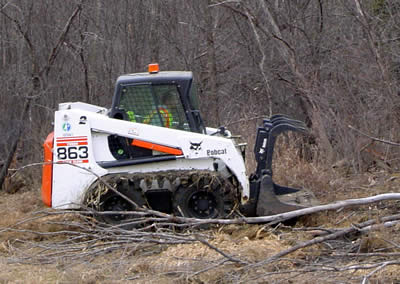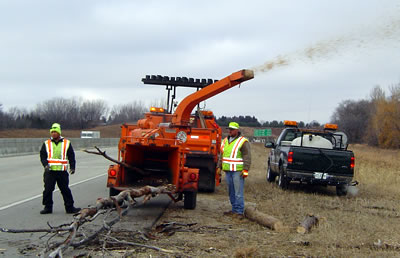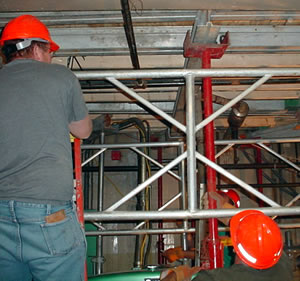By Craig Wilkins

Using a specially equipped skidsteer, Joel Kroening, transportation generalist at Rochester, cuts brush along Hwy 52. Photo by Dave Redig
|
What do Mn/DOT maintenance crews do when the winter is warm and snow a very scarce commodity?
“Plenty,” said Beverly Farraher, the Metro District’s acting maintenance engineer.
Until Feb. 5, when Minnesota was hit with a one-two punch of bitter cold and snow, the state enjoyed what might be called an extended autumn. During the long reprieve from plowing snow and performing other winter-related duties, maintenance crews were doing a lot of different kinds of work. Some were learning new skills as well.
At Metro, maintenance forces expanded the district’s anti-icing coverage area for bridges and other areas prone to experience black ice conditions. Crews also used the time to replace toppled signs, and repair guard rails, crash attenuators and fences.
Other outside work included removing brush and cleaning drains, grit chambers and culverts and other parts of highway drainage systems.
Inside activities ranged from cross-training staff on equipment used in summer and performing annual and other maintenance work on equipment.
Winter’s late arrival also allowed maintenance employees to attend construction certification classes to prepare them to inspect construction projects.
At Golden Valley, Farraher said bridge crew members are repairing the boiler room floor, saving the state thousands of dollars.

Maceo Douandgy (at left) and Jason Polzin, run brush through a chipper during brushing operations on Hwy 52 south of Rochester. Both are transportation generalists at Rochester. Photo by Dave Redig
|
Similar situations prevailed in Greater Minnesota districts as well.
District 6 crews caught up with backlogged brush cutting and tree removal work on several highways in southeastern Minnesota.
“The warm weather was a godsend to us,” said Dave Redig, maintenance superintendent at Rochester. “We were able to catch up some on brushing, guard rail maintenance and even do some drainage repair work until the cold set in.”
Crew members also took advantage of the weather to remove 74 dead elm trees along Hwy 52 near Rochester.
The district received about 22 inches of snow so far this winter, Redig said. He notes, however, the snow accumulation was spread over many storms, some dropping only a fraction of an inch.
Jeff Butson, maintenance superintendent with District 8, said the mild early winter months allowed the district to do pothole patching and clear brush from road corners to improve sight distances. The bridge crew started two projects: building a new salt shed at the Litchfield truck station and installing tile on hallways at the district headquarters in Willmar.

Metro District bridge workers Pat Stoddard and Steve Matis adjust under-floor shoring for concrete removal before installing a new floor in the Golden Valley office’s boiler room. Photo by Michael Ramberg |
When the bitter cold did arrive, Butson said district maintenance staff made the best use of it as well.
“Dennis Marty brought the Willmar sub-area crews together for a day to plan this summer’s work,” he said. “Here at Willmar we did safety and other kinds of training. It was just too cold to send people outside unless we really had to.”
Northern Minnesota maintenance forces also took advantage of the mild, early part of winter.
Tim Sheehy, District 1 maintenance superintendent, said district crews did patching, equipment maintenance and extensive brush cutting.
As in other districts, bridge crew members turned their skills to facility projects, including enlarging the salt storage shed at Hibbing.
The weather, he said, also allowed maintenance forces to attend scheduled training such as creating a respectful work place.
Sheehy said the light snow accumulation (six to 10 inches in most places) enables crews to clear ditches of vegetation now even though the region is experiencing bitterly cold temperatures.
“It’s easier to get in there now than in the spring or in the fall—and there are no bugs,” he said.
Steve Lund, state maintenance engineer, said a significant amount of important work was accomplished that wouldn’t usually get done because crews were freed from plowing and other winter tasks.
Lund noted, however, that maintenance crews must stay alert regardless of weather conditions.
“Although we did experience a long run of mild winter weather, small but frequent snow storms like we’ve had earlier and other conditions always require due diligence,” Lund said. “Maintenance crews must be able to switch to snow-fighting work whenever weather and road conditions demand it.”
|



